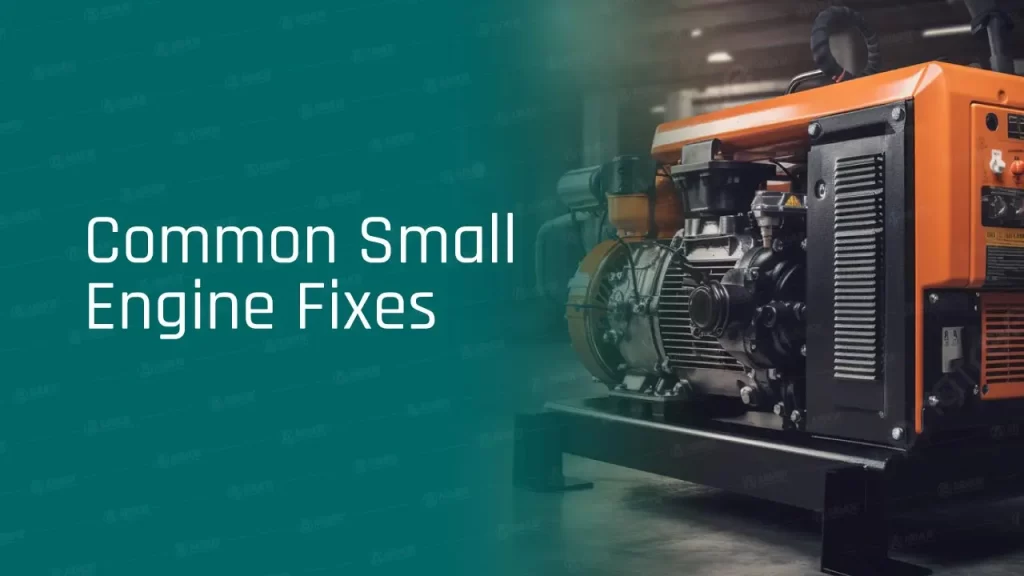- Armor Blog
- Consumer Education
- Troubleshooting Small Engine Problems Easy Tips

You start searching for Common Small Engine Problems when you try to use your lawn mower, chainsaw, or generator and suddenly it is not working! I’ve been there and believe me it can ruin your day!
You are probably reading this article because you are in this situation, and therefore i will guide you to find the best fix. I will also help you avoid getting in this situation in the future.
Differences Between Small Engines and Car Petrol Engines
Many thinks about why small engines breaks down more often than car’s engine. It seems weird when you do not know how different both of these engines. Similarities are present between small engines and car petrol engines, but they differ in design, performance, and application.
Engine Size and Power
Small engines are compact and designed for low-power applications. Typically range from 25cc to 750cc, making them ideal for lawnmowers, generators, and motorcycles.
Car petrol engines, in contrast, start at around 1000cc and can exceed 6000cc, providing significantly more power for heavier vehicles.
Fuel and Combustion Process
Most small engines operate on a simpler carbureted fuel system, while modern car petrol engines use fuel injection technology for efficient combustion.
Cooling System
Small engines rely on air cooling, which dissipates heat using fins and natural airflow.
Car petrol engines, however, use a liquid cooling system with radiators and coolant, allowing better heat management for prolonged operation.
Tips for Troubleshooting a Small Engine that won’t Start
Owning machines like mower or generators teaches you that it is not that hard to determine why your small engine isn’t working!
Small engines are simple, and most issues can be fixed without a professional mechanic. If your engine refuses to start, checking a few key components can help diagnose the problem.
Inspect the Spark Plug
A faulty spark plug often prevents the engine from starting. Check for signs of wear, cracks, or carbon buildup on the electrode.
Replacing a damaged spark plug usually resolves ignition issues. Using a spark plug tester helps determine if the plug is still functioning. If no spark appears at the terminals, installing a new one is necessary.
Clean the Carburetor
A clogged carburetor disrupts the air-fuel mixture, causing startup problems. Old fuel can leave sticky residue, blocking fuel flow. Using a carburetor cleaner removes minor clogs, but severe buildup may require a rebuild or replacement. Keeping the carburetor clean improves engine performance and reliability.
Check the Compression System and Valves
Compression leaks affect power delivery in small engines. Piston, valves, and rings control airflow and fuel movement. Damaged piston rings or leaking valves reduce engine efficiency, making startup difficult.
Examine the Ignition Coil
The ignition coil supplies voltage to the spark plug. A defective coil prevents proper ignition, stopping the engine from starting. Testing the coil’s continuity with a multimeter helps confirm if it needs replacement. Replacing a faulty coil restores ignition function.
How to Avoid Common Small Engine Problems?
Small engines power a variety of equipment, from lawn mowers to snow blowers. Preventative maintenance helps keep them running properly and reduces the need for repairs.
Buy High-Octane Fuel Specified for Small Engines
Small engines perform best with non-ethanol fuel. Ethanol can degrade rubber fuel lines and gaskets if left sitting in the carburetor for long periods. Checking the owner’s manual for fuel recommendations prevents improper fuel use, which may cause engine damage.
Learn how the right engine oil prevents engine damage and save your money in this informative blog post.
Buy Only Enough Fuel to Last a Month
Gasoline degrades within 30 days, forming varnish and gum deposits that clog fuel passages. Purchasing only the amount needed for a month prevents stale fuel from affecting performance. Keeping fuel fresh reduces carburetor issues and ensures clean combustion.
Use Fresh Gas
Closing the inline fuel shut-off valve after using the equipment allows the carburetor to run dry, reducing the chances of stale fuel buildup. Reopening the valve before the next use keeps the engine ready to start without trouble.
Use a Fuel Additive
Adding a fuel stabilizer helps prevent corrosion and deposits. Stabilizers keep fuel fresh for up to 12 months, making them essential for equipment stored between seasons. Using an additive every time the tank is refilled enhances fuel system cleanliness.
Prepare Your Small Engine for Seasonal Storage
Before storing a small engine for the season, drain the fuel from the tank and carburetor to prevent stale fuel from clogging components. Changing the engine oil while the engine is warm allows for more complete drainage. Following the owner’s manual for oil recommendations keeps internal parts properly lubricated.
Avoid Storing Equipment Outside
Leaving power equipment exposed to rain or snow leads to water contamination and corrosion. Storing it in a garage or shed extends its lifespan. If indoor storage isn’t an option, covering equipment with a durable tarp helps protect it from the elements.
Routine maintenance and proper fuel management prevent most small engine problems. Following these simple steps keeps your equipment running properly and minimizes repair costs.




 Spear Lubricants
Spear Lubricants Armada lubricant
Armada lubricant Ace lubricants
Ace lubricants Perfect lubricants
Perfect lubricants Enzo lubricants
Enzo lubricants Lawrence lubricants
Lawrence lubricants